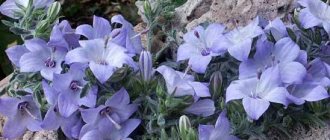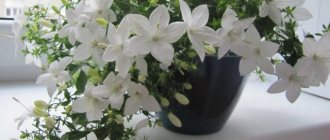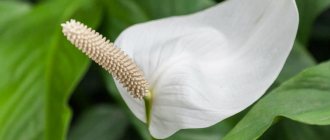This is a very interesting representative of the flora with a rather complicated history.
- Its official name is translated from Italian as “bell”.
Indeed, the buds hanging down resemble cast belfries.
They say that initially this delicate bush was often found on the Apennine Peninsula. More precisely, in the province of Campania, the birthplace of copper bells. And it was actively bred in the monastery gardens. Is this why the signs contain a subtle hint: it was the campanula flower that “told” the monks the shape and name of the bell. And not the other way around...
How to care for bride and groom flowers
Not everyone knows how to care for a plant. This herbaceous plant is very picky to care for. But its lifespan is no more than two years.
After this time, it begins to stretch and dry out, so it is better to renew it. There will be no problems with the way the bell reproduces.
It can be propagated by seeds and cuttings, without any abstruse tricks. You just need to collect round seed pods or trim shoots from a 2-year-old plant.
Regular universal peat soil will be quite suitable soil for planting campanula. Good drainage is mandatory because the bell does not tolerate stagnant moisture.
Seeds are sown superficially when they are not covered with soil. Simply spray generously from a spray bottle and cover with film. Create a greenhouse effect. Sprouts appear in 3-5 days. Then the sprouts are picked and planted.
Saplings "Bride and Groom"
Advice. If the cutting method is used, then the cut shoots of the old plant are placed in water with “root” or any other preparation for the best root formation. On day 3-4, thin white roots will begin to form. This means that it can already be planted in the ground, creating a greenhouse effect after planting for better rooting.
Who should buy the bouquet?
Signs about the bride's bouquet clearly state that it should be bought by a man, usually the groom. With the help of a bouquet, he entrusts his heart to his beloved and promises a happy life with him. But if for some reason he cannot buy it, then this is allowed to be done by the father or a close friend of the groom, who is usually a witness.
Modern wedding fashion requires that the bouquet be combined with the bride’s outfit, so girls often choose it themselves. But, if you want to maintain traditions, then all your participation should be limited to wishes for the colors from which it will be composed. But the choice should remain with the groom.
Major diseases
The “bride and groom” are also very unpretentious in their care. Watering can be done once a week on a tray, because, given its density, it is almost impossible to water the plant at the root.
It is not advisable to spray the plant itself and the flowers, since the leaves and flowers of the bell are very delicate. Putrefactive spots may begin to form on the surface and gray rot may appear, which is very detrimental to campanula.
Lack of sufficient watering can lead to spider mites. Therefore, it is worth treating the bell with special preparations immediately upon purchase or planting.
Important. The plant does not require replanting for 2 years because it is renewable. Care includes plucking faded buds and watering.
Purchasing a plant
Before you begin implementing our recommendations, you need to purchase the plant itself. You can buy it in stores by browsing the flower departments. I must say, he is not a very frequent visitor to such places. But if you are lucky, you will become the happy owner (or possessor) of this green pet.
The second purchasing option is to buy from grandmothers. Ask around, maybe someone will agree to sell you a young plant.
Checking roots
If the root system looks pretty good externally, do not rush to replant the beauty. Firstly, she needs to undergo acclimatization in your apartment or house. This is a stressful situation, and if you add to it a replanting with freeing the roots from the soil, it will not be difficult to destroy the flower.
Dilute the drug “Fitosporin” in water. The color of the concentrate should resemble strong black tea. From this concentrate, prepare a solution for irrigation: 15 drops per liter of irrigation water. Spray the plant with Fitosporin. This needs to be done as soon as you arrive home and look at the roots. “Fitosporin” will destroy fungi and spores that contribute to the spread of root and other rot.
Pest treatment
Now let's examine the green mass of the plant. Often unexpected guests “come” to us from the store - all kinds of pests that attack leaves and flowers. If light spots are noticeable or something else bothers you about the general appearance of the plant, treatment is needed. You can use “Fitoverm” or “Intavir”. Dilute the drug according to the instructions and treat the above-ground part of the plant. By the way, you can also water the ground if the soil allows it.
Trimming shrunken parts
We can say that your indoor flower “bride” has been saved. How to care next? Remove any blooms on the plant. Carefully cut off damaged leaves and broken stems with sharp scissors. Now your “bride” is almost ready for the next step of post-purchase processing.
Campanula transplant
A newly purchased campanula should not be disturbed for several days, during which time it must adapt to new conditions. After this, it must be transplanted. To do this, use a wide pot, at the bottom of which a good drainage layer is made. A suitable soil mixture must be loose, its composition: peat, humus, coarse sand and leaf soil (1: 1: 1: 1).
Next, the bush is replanted in the spring at the very beginning of active growth. But experienced flower growers advise not to replant the old bush, but to grow a new flower from cuttings in the spring.
Correct lighting
Campanula feels great in street plantings. You just need to choose a place that is not too sunny and without direct rays. The same lighting principle should be followed at home.
It is better if the window for the bell faces west or southwest, then the flowering will become abundant and friendly. After all, even the leaves of a blooming campanula are not visible, it is so densely strewn with flowers.
This flower looks very impressive in the following places:
- ampel plantings;
- hanging flowerpots;
- discounts;
- flower beds;
- curbs.
It harmonizes perfectly with petunia, matthiola and other garden flowers. The bride and groom also feel good in the Alpine slides. Exuberant flowering will undoubtedly decorate the entire composition.
Interesting. The name “bride and groom” began to be used because of the color of these delicate flowers. White and blue flowers are often planted in the same pot, where they intertwine and seem to gently hug each other.
At home, bellflower is one of the most unpretentious plants. Spectacular, very abundant flowering from spring to late autumn makes it one of the favorite indoor plants.
Details
VARIETIES
Terry hybrids. The bush is small in size, with large double flowers. The stems are shortened, the leaves are densely arranged. This species was obtained by crossing the Carpathian bellflower and Campanula sparrowfolia.
Important! Terry forms of flowers are more unpretentious and do not take root with all amateur gardeners.
Carpathian campaign. A herbaceous bush up to 30 cm high. The leaves have an oval shape and are located below under the guise of a basal rosette. The flowers are painted in white, blue, lilac and violet shades, and are quite large in size. Flowering lasts from May to August. The flower grows in wild and domestic conditions. The street flower is found in the Carpathian mountains.
REPRODUCTION
Like many house plants, Campanula needs propagation for rejuvenation purposes. The most effective way is cuttings. But the flower can also be propagated by seeds, green shoots and dividing the bush.
Cuttings
The petioles are cut off at the end of summer, when they are sufficiently strong and mature. For propagation, use the lower part of the plant with healthy cuttings of 10 cm. Such a strong cutting is cut off and placed in a weak solution of potassium permanganate. After 6-7 hours in the solution, it is changed to clean water until roots appear. You can enhance the appearance of roots with the help of Kornevin. When roots appear, the flower is transplanted into a mixture of peat and sand and creates a greenhouse effect.
Flower growers recommend replanting several cuttings into one pot for density. To do this, use a glass jar or polyethylene cap. The optimal temperature under the hood is 20-24°C. In the morning and evening, the greenhouse should be opened slightly and sprayed with water. As the cuttings take root, the plant will need more and more fresh air. Once the roots have taken root, the greenhouse can be removed. In the spring, Campanula propagated from cuttings can bloom with proper care.
Signs and superstitions
Often, regarding indoor plants, and not only, there are many superstitions and signs. And the campanula did not escape a similar fate. But unlike many other flowers that are expelled from homes for fears invented about them, campanula has received the most flattering reviews.
It is believed that if there is a “bride and groom” in the house, then the owners and members of their family are not in danger of damage or the evil eye. The bell is a symbol of the hearth and a talisman for family happiness. It is considered a good omen to give a “bride and groom” as a wedding gift, as a talisman for a young family.
Benefit
It's no secret that the ringing of church bells scares away evil spirits.
This plant has the same effect. A campanula standing in a tabletop vase will be a good talisman against negative energy seeking to enter the house. All dark entities and unkind people will not fall into it.
Blue bells planted in a garden or flower bed will bring well-being and prosperity to the site, the house and its inhabitants. That is why they are often used in cultural plantings.
What is an indoor flower “Bride and Groom”
People more often hear other names for the flower: “Bride and Groom”, “Bell” or “Flower of Family Happiness”.
The plant, due to its color and abundant flowering, carries positivity, joy, love of life and is associated with a wedding.
The species diversity of Campanula is great, but for growing at home, only one is most often used - equileaved, which is a perennial climbing plant with a stem up to 30 cm long.
The shape of the leaves resembles a bell, hence one of its names.
In addition to this variety, Campanula Karpatskaya, Campanula Blauranka and terry are available for indoor use.
“Bride and Groom” are unpretentious and do not require special care.
The plant has two bright colors - white and blue, so it is recommended to take a pair so that they complement each other and bring only a positive attitude to gardeners and give them their advantages.
Plant care
Bluebells prefer places where there is no direct sunlight, but the dark sides of the room are also undesirable. A space with good lighting, such as the eastern part of the house, is ideal.
The ideal temperature is 24 degrees. Watering should be done once or twice a day.
Excessive moisture can cause gray rot, a very dangerous disease for plants, and if rare, there is a high risk of spider mites.
Fertilizers are applied once every 15 days.
Faded inflorescences must be trimmed to keep the plant cheerful and well-fed.
Positive signs
“Bride and Groom” have a number of positive signs that characterize the plant as the most suitable for any gardener and any room.
With proper care, Campanula fills the home with positive energy.
The bride and groom are purchased as a couple, but in different colors, then there will be a good mood and a charge of energy for all residents of the house.
Bells are excellent collectors of negativity from the whole family.
The flower helps in relieving stress and solving stressful situations.
Campanula is a symbol of a happy family life, giving all household members positive energy.
When a flower suddenly disappears, nothing helps bring it back to life, which means it has taken damage or the evil eye from one of the residents of the house. When this happens, the plant must be thanked for its service and buried in the ground in nature.
If the newlyweds are presented with a flower of two colors, then the guests will bestow mutual love and happiness on the newlyweds, which will never leave them.
Negative signs
First of all, all gardeners study the desired plants for negative signs.
Everyone wants to get a leafy pet with excellent characteristics and numerous advantages, but they are completely afraid of acquiring a number of problems.
With joy for all flower lovers, the bride and groom are a positive plant and do not carry negativity, and no negative signs are insignificant for him.
If in other plants changes in appearance are characterized by something supernatural, then for Campanula it is not the right care.
When the leaves turn yellow or faded, the plant has a lot of bright light and needs to be moved to a shaded place.
The stems have become thin and elongated, but the flower, on the contrary, does not have enough light.
If the leaves are limp and the light regime is maintained, it is necessary to reduce the water level for irrigation.
Campanula is an original flower and should be on your windowsill.
The bell is a wonderful decorative element and a carrier of positivity, which extends to all its owners. Having no negative signs, it will be a wonderful find for all flower growers.
The Campanula plant is of European origin, but has a Russian soul. It is close to us due to its kinship with the simple field bell. This beauty can easily decorate our windows and garden and delight us with its blooms all summer long, because it is unpretentious in care and reproduction. You will see this by reading the article.
General information
DESCRIPTION
The Bride and Groom are distinguished by their special characteristics: shape, color, size of flowers. The plant is a hybrid terry plant with creeping thin shoots that can hang down up to 25 cm. The leaves are arranged alternately and have a heart-shaped round shape. The color of the leaves varies from light green to dark green. There are also varieties with purple and pink flowers. The petioles are long with leaf blades on the stems. The inflorescences include two to four bell-shaped flowers. The flowers consist of 5 petals, 4 cm in diameter.
Interesting fact! The Bride and Groom flower is considered the best gift for newlyweds. According to the sign, he can help create a strong family, fill life with happiness, improve the energy at home and relieve stressful situations.
BLOOM
Flowering lasts from early May to late summer. Flowering of a young plant will occur 1.5 years after planting under the necessary conditions. After flowering, a small fruit, similar to a box, remains on the plant. Next, the plant needs rest. In order for new buds to appear, you need to cut off dried shoots and flowers from the plant before resting. Pruning is done in late autumn-early winter (October-December), leaving only 2-3 buds. The stems are shortened by 12 cm. In the spring, they are pruned again, leaving 5 cm of their own length. Dormant buds will wake up and new, strong shoots will develop from them.
Flowering ends approximately 3 years after planting, when lignification of the shoots occurs. One of the options for rejuvenation is cuttings at the end of February.
REST STATE
The dormant state occurs after the end of the growing season, in late summer - early autumn. At this time, you need to cut off elongated shoots, place the pot in a cool place, and limit watering to 1-2 times a month. With the onset of spring days, the flower comes to life, wakes up, it puts out new shoots, and it is transferred to a warm place.
Growing Campanula at home
Choosing the right place
The most suitable for growing Campanula will be the eastern or western side of the home. Placement method: hanging flower pots or stands. Due to the hanging stems, if possible, it is necessary to avoid placing them on simple horizontal surfaces such as window sills. During the summer months it is useful to move the pots to an open/indoor terrace or balcony. It is even possible to plant it in the garden or near southern windows, provided it is shaded from direct midday sunlight. The movement and rotation of the Campanula relative to the light source have a negative effect, since the plant spends a lot of energy turning the leaves; in addition, during this period the flower does not receive ultraviolet radiation and, as a result, may stop flowering.
Lighting
It should be plentiful. Daylight hours during the flowering period of Campanula are recommended to last 14-15 hours. Under growing conditions in central Russia, these are real numbers, so additional lighting will not be needed. Direct sunlight can cause burns and leaf fall; lack of light leads to the plant stretching and loss of foliage brightness. Even in the winter months, during the dormant period and with a small number of branches, lighting is maintained at a high level: the plant is placed close to the windows, thus killing the second “hare” - the temperature is maintained at a low level.
Watering
Like other seasonal plants, the moisture regime is divided into 2 periods. From April to August, Campanula requires abundant watering: 1-2 times a day if there is good drainage.
Drainage is the bottom layer in a pot that allows you to separate the water in the pan and the main soil. Prevents stagnation of water in the pot and rotting of the roots.
From October, during the dormant period, watering is reduced to once a week in the fall, and once a month in the winter. A distinctive property of the Bluebell is its ability to tolerate short periods of drought painlessly. Depending on the humidity and temperature of the surrounding air, this period can last up to 14 days. Hard tap water is suitable. If there is chlorine in its composition, it still takes a day to weather it. Frequent watering results in abundant flowering and large green mass. And resistance to drought is provided by a massive root system.
Content temperature
During the period from spring to autumn, the temperature range can fluctuate between 20-35°C. In this sense, Campanula is unpretentious. In winter there is no need for warmth; a rest period at 10-14°C is desirable.
Soil and replanting
A universal store-bought mixture for flowering plants is suitable. For those who like to prepare the composition themselves, a recipe is offered: leaf soil, peat, sand, humus, mixed in equal parts. Campanula is transplanted annually before the period of active growth using the transshipment method. The pot is selected low, but large in diameter. The distance from the root system of the transplanted Bell to the walls of the new pot should be at least 2 cm. A drainage 1/3-1/4 high from the height of the pot is placed on the bottom.
Fertilizer application
Performed at intervals of 2 weeks throughout the entire season of active growth and flowering of Campanula. Complex mineral and organic fertilizers for domestic flowering plants are quite suitable for use.
Fertilizers
The use of complex fertilizers will allow you to obtain flowers with bright colors
Use mineral and organic fertilizers 2 - 3 times every thirty days (spring and summer). Water once every two weeks with special fertilizers for beautifully flowering indoor plants.
Diseases and pests
Campanula is susceptible to attack by spider mites, scale insects, and thrips. In the first two cases, insecticides are used (Fitoverm is the most widely used), in the third, fungicides. If the root system is always in waterlogged soil, gray rot or mold may appear. The signal will be brown or “snotty” leaves. In this case, it is necessary to replant the plant with revision of the roots and removal of damaged areas. With a lack of watering or excessive lighting, the leaves dry out and fall off. The solution is to change the conditions of detention.











